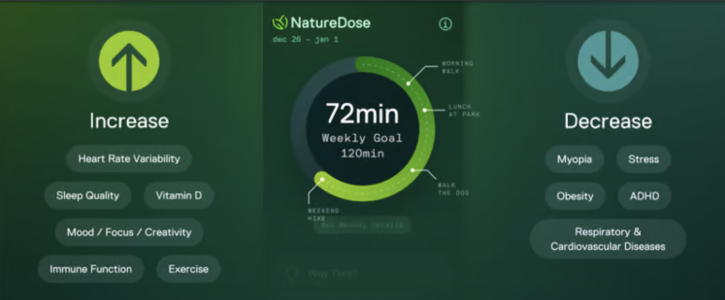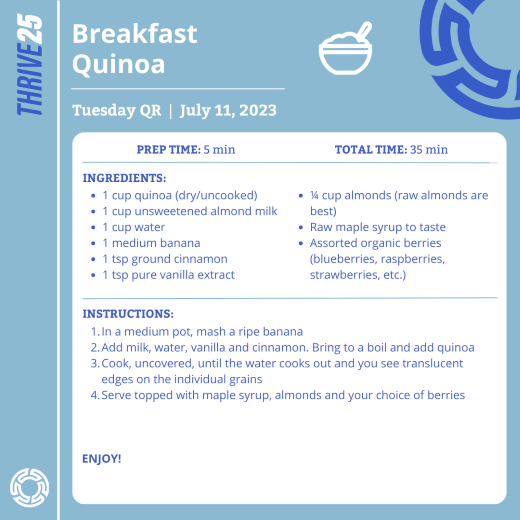Issue #211: Weed as Medicine
Good morning. It’s Tuesday, July 11th.
Today’s Quick Win
From the Lab: Weed as Medicine
Speed Read: Lead Cables All Over the U.S.
Tuesday QR: Breakfast Quinoa
“Make it simple for yourself by calming your mind from anger, understanding what makes you sad, and replicating the experiences that make you happy. If you want strength and success, just do it!”
The percentage of Americans who have tried marijuana. (Pew Research)
From the Lab
You know what’s crazy - in October 2012, just over 10 years ago, no one in the United States could legally purchase marijuana for recreational use.
That same year (2012), police made 750,000 marijuana-related arrests.
Fast forward to today - 23 states have legalized marijuana sales and another 7 states have decriminalized the drug. (38 states allow for medical marijuana).
While cannabis is still illegal under the Controlled Substance Act of 1970, the federal government is no longer focused on pot smokers and gummy eaters.
How did Mary Jane become accepted across states so quickly?
Well, public opinion for starters - in October 2022, 88% of adult Americans say marijuana should be legal for medical and/or recreational purposes.
The top two reasons for legalization:
Significant medical benefits
Free up law enforcement resources
So does marijuana offer significant medical benefits?
It’s important to put medicine in the context of what it’s solving and what it’s replacing.
Over 50 million Americans (21% of the population) are living with chronic pain. This led to the opioid epidemic - notably with Oxycontin and other addictive pain killers.
These drugs themselves are incredibly addictive and dangerous and also gateway drugs to even more lethal substances like fentanyl - leading to 80,411 deaths in 2021.*
Cannabis has been shown to be a very significant pain reliever - without the risk of death.
One way to measure this is with the Therapeutic Index. This is the median lethal dose (LD) divided by the minimum effective dose (ED). It’s a proxy for safety and being effective without being toxic.
Even OTC drugs like Tylenol have an Index score of 10 - meaning if you take 10x the recommended dose you are at significant risk of death.
Cannabis meanwhile, has an Index score above 20,000. That’s not to say you should take that much - but risk of death is very low.
The plant
The cannabis family of plants is pretty complicated. There are different active compounds in the plants.
Without getting too into the weeds (dad joke), we often hear about THC and it’s psychoactive effects “getting high” and CBD, which does not have these effects.
CBD can come from the marijuana plant or from hemp - which has less than 0.3% THC.
These compounds bind to our C1 and C2 receptors in the brain that triggers changes in the body with the release of neurotransmitters throughout our central nervous system (CNS).
The reason it’s a challenge to get into more detail is the crazy complicated way these compounds affect our brain and how much it varies from one person to another.
That’s why you can have results from a study showing that CBD reduced or eliminated opioid use in 53% of patients and then only reduced pain by 1.5 points on an 11 point scale in another study.
Here’s a summary of the types of CBD.
If you or anyone you love is dealing with chronic pain, recovery from chemotherapy, ALS, seizures, PTSD, or other awful symptoms disrupting sleep and daily life - talk to a trusted medical professional about the potential of these cannabis compounds.
Be aware that everyone is different in how they react to CBD, and especially THC. But two things for everyone to keep in mind:
Mold often grows in indoor plants and can be very destructive on anyone with immune issues or other health risks - be sure to get the highest quality, third-party verified products available
There are some results showing risk to the liver. If you have or suspect you may have any liver issues talk to your medical partner before taking any form of cannabis
*Dopesick, with awesome actor Michael Keaton, was a powerful visualization of the power of the opioid epidemic
Thrive25 Partner Spotlight
NatureDose is a free app to help you set a weekly nature goal and track your progress. It’s actually the anti-app. It uses GPS and machine learning to track your time outside and give you that extra boost to actually enjoy nature.
On par with diet, exercise, or adequate sleep, making nature exposure an essential part of your lifestyle is one of the best choices you can make for your health. Check out NatureDose.
Speed Read
Health & Longevity in the News
Day Drinking: We covered alcohol a few weeks ago (Issues #193, #194) - check out those issues to understand the impact of alcohol on your body. If you were paying attention, you may have asked, is drinking earlier in the day better for you? Kinda... (NYTimes)
Got the Ill Communications: No amount of contact with lead is safe. But lead cables laid from the late 1800s to the 1960s are all across America (even under Lake Tahoe) and it’s in our drinking water (in some areas 10x+ safe amounts). Problem is - after the 1984 split of AT&T no one “owns” these cables anymore. (WSJ)
New Tech for MRI Scans: Medicine 2.0 (our current system) - is based on being reactive when you’ve got a problem. But a new set of companies are now offering full-body MRI scans to identify potential issues before they become problems. Can AI make these a reality for effective preventive health? (CNET)
Tuesday QR | Breakfast Quinoa
This is a little longer Quick Recipe, but it’ll be worth it - quinoa is packed with protein and we top it with superfoods to start your day. There’s also only about 5 min active time, so not too time-intensive - you can read the newspaper 📰 or have a convo with your partner while it’s cooking.
Thanks for joining us today!
Check out the latest workout videos on our YouTube channel
Got feedback, recommendations or stories to share? Tell us what’s on your mind here
Want this direct to your inbox? Sign up here
Why Thrive25
We’re 40-something dads that felt our bodies and minds start to slow down and we’re not ready for that. We found too much information on every subject. So we started Thrive25 to transform what we’ve learned into something useful for the rest of us to spend just 3-5 min a day to optimize our health & longevity.
This newsletter is for you and we truly value your feedback. Never hesitate to reach out to us at team@thrive25.com.
To health!
Sign up for free:
The information in this newsletter is for informational purposes only and may not be appropriate or applicable based on your individual circumstances. Thrive25, Inc. does not provide medical, professional, or licensed advice. Please connect with your healthcare professional for medical advice specific to your health needs.











